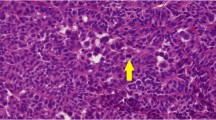Abstract
The WHO classification of testis tumours includes the group of sex cord-stromal tumours. They are divided into several histological types, i.e. Leydig cell (LCT) and Sertoli cell tumours (SCT). Based on the physiological expression of β-catenin in normal testis/Sertoli cells, it was previously shown that SCT can carry a β-catenin mutation, causing a nuclear positivity for β-catenin and cyclin D1. Furthermore, it could be shown that the stabilization of β-catenin in Sertoli cells causes the loss of the Sertoli cell marker SOX9. We wanted to know whether the stabilization of β-catenin in sex cord-stromal tumours influences SOX-9 expression and thus could be used in the diagnosis of sex cord-stromal tumours. Therefore, 53 cases of sex cord-stromal tumours and tumour-like lesions were investigated for their immunohistochemical expressions of β-catenin, cyclin D1 and SOX9. In addition, mutation analyses of the β-catenin gene (exon 3; CTNNB1) were performed. β-catenin mutation in SCT results in nuclear β-catenin and cyclin-D1 expressions on immunohistochemical analysis. The nuclear expression/stabilization of β-catenin causes the loss of SOX9 in these tumours. In contrast, SOX9 is considerably expressed in non-mutated SCT as well as in Sertoli cells of non-neoplastic testes. In summary, immunohistochemical analyses of β-catenin and SOX9 are useful to distinguish SCT from other sex cord-stromal tumours of the testis. Furthermore, the presence of SOX9 indicates that the cells of origin may be Sertoli cells.




Similar content being viewed by others
References
Oliva E, Young RH, Ulbright TM (2016) Sex cord-stromal tumours. In: Moch H, Humphrey PA, Ulbright TM, Reuter VE (eds) WHO classification of tumours of the urinary system and male genital organs. IARC, Lyon
Xiao GQ, Granato RC, Unger PD (2012) Bilateral Sertoli cell tumors of the testis—a likely new extracolonic manifestation of familial adenomatous polyposis. Virchows Archiv : an international journal of pathology. 461(6):713–715. doi:10.1007/s00428-012-1332-x
Galiatsatos P, Foulkes WD (2006) Familial adenomatous polyposis. Am J Gastroenterol 101(2):385–398. doi:10.1111/j.1572-0241.2006.00375.x
Aoki K, Taketo MM (2007) Adenomatous polyposis coli (APC): a multi-functional tumor suppressor gene. J Cell Sci 120(Pt 19):3327–3335. doi:10.1242/jcs.03485
Lips DJ, Barker N, Clevers H, Hennipman A (2009) The role of APC and beta-catenin in the aetiology of aggressive fibromatosis (desmoid tumors). European journal of surgical oncology: the journal of the European Society of Surgical Oncology and the British Association of Surgical Oncology 35(1):3–10. doi:10.1016/j.ejso.2008.07.003
Nollet F, Berx G, van Roy F (1999) The role of the E-cadherin/catenin adhesion complex in the development and progression of cancer. Molecular cell biology research communications: MCBRC 2(2):77–85. doi:10.1006/mcbr.1999.0155
Perrone F, Bertolotti A, Montemurro G, Paolini B, Pierotti MA, Colecchia M (2014) Frequent mutation and nuclear localization of beta-catenin in Sertoli cell tumors of the testis. Am J Surg Pathol 38(1):66–71. doi:10.1097/PAS.0b013e31829cdbc6
Morin PJ, Sparks AB, Korinek V, Barker N, Clevers H, Vogelstein B et al (1997) Activation of beta-catenin-Tcf signaling in colon cancer by mutations in beta-catenin or APC. Science 275(5307):1787–1790
Chaboissier MC, Kobayashi A, Vidal VI, Lutzkendorf S, van de Kant HJ, Wegner M et al (2004) Functional analysis of Sox8 and Sox9 during sex determination in the mouse. Development 131(9):1891–1901. doi:10.1242/dev.01087
Chang H, Gao F, Guillou F, Taketo MM, Huff V, Behringer RR (2008) Wt1 negatively regulates beta-catenin signaling during testis development. Development 135(10):1875–1885. doi:10.1242/dev.018572
Bremmer F, Strobel P, Jarry H, Strecker J, Gaisa N, Strauss A et al (2015) CK19 is a sensitive marker for yolk sac tumours of the testis. Diagn Pathol 10:7. doi:10.1186/s13000-015-0243-y
Zhang C, Ulbright TM (2015) Nuclear localization of beta-catenin in Sertoli cell tumors and other sex cord-stromal tumors of the testis: an immunohistochemical study of 87 cases. Am J Surg Pathol 39(10):1390–1394. doi:10.1097/PAS.0000000000000455
Kim Y, Kobayashi A, Sekido R, DiNapoli L, Brennan J, Chaboissier MC et al (2006) Fgf9 and Wnt4 act as antagonistic signals to regulate mammalian sex determination. PLoS Biol 4(6):e187. doi:10.1371/journal.pbio.0040187
De Santa BP, Bonneaud N, Boizet B, Desclozeaux M, Moniot B, Sudbeck P et al (1998) Direct interaction of SRY-related protein SOX9 and steroidogenic factor 1 regulates transcription of the human anti-Mullerian hormone gene. Mol Cell Biol 18(11):6653–6665
Moniot B, Declosmenil F, Barrionuevo F, Scherer G, Aritake K, Malki S et al (2009) The PGD2 pathway, independently of FGF9, amplifies SOX9 activity in Sertoli cells during male sexual differentiation. Development 136(11):1813–1821. doi:10.1242/dev.032631
Bouma GJ, Albrecht KH, Washburn LL, Recknagel AK, Churchill GA, Eicher EM (2005) Gonadal sex reversal in mutant Dax1 XY mice: a failure to upregulate Sox9 in pre-Sertoli cells. Development 132(13):3045–3054. doi:10.1242/dev.01890
Papanastasopoulos P, Repanti M, Damaskou V, Bravou V, Papadaki H (2008) Investigating differentiation mechanisms of the constituent cells of sex cord-stromal tumours of the ovary. Virchows Archiv : an international journal of pathology 453(5):465–471. doi:10.1007/s00428-008-0677-7
Kao CS, Cornejo KM, Ulbright TM, Young RH (2015) Juvenile granulosa cell tumors of the testis: a clinicopathologic study of 70 cases with emphasis on its wide morphologic spectrum. Am J Surg Pathol 39(9):1159–1169. doi:10.1097/PAS.0000000000000450
Al-Fageeh M, Li Q, Dashwood WM, Myzak MC, Dashwood RH (2004) Phosphorylation and ubiquitination of oncogenic mutants of beta-catenin containing substitutions at Asp32. Oncogene 23(28):4839–4846. doi:10.1038/sj.onc.1207634
Acknowledgements
We thank Valerie Unterkircher and Stefan Kueffer for the perfect technical assistance. Felix Bremmer is supported by the research program of the Faculty of Medicine, Georg-August-University Göttingen and the Wilhelm-Sander-Stiftung (2016.041.1).
Author information
Authors and Affiliations
Corresponding author
Ethics declarations
Ethical approval
Ethical approval for using human material in the present study was obtained from the ethics committee of the University Medical Centre Göttingen (application number: 2/6/16).
Conflict of interest
The authors declare that they have no conflict of interest.
Rights and permissions
About this article
Cite this article
Bremmer, F., Behnes, C.L., Schildhaus, H.U. et al. The role of beta-catenin mutation and SOX9 expression in sex cord-stromal tumours of the testis. Virchows Arch 470, 421–428 (2017). https://doi.org/10.1007/s00428-017-2090-6
Received:
Revised:
Accepted:
Published:
Issue Date:
DOI: https://doi.org/10.1007/s00428-017-2090-6




